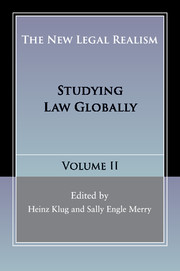Book contents
- Frontmatter
- Dedication
- Contents
- List of contributors
- Preface to The New Legal Realism, Volumes I and II
- 1 Introduction
- Section I The Globalization of Law
- 2 African Constitutionalism From the Bottom Up
- 3 Human Rights Monitoring, State Compliance, and the Problem of Information
- 4 Intellectual Property and the Creation of Global Rules
- Section II The Global Transfer of Norms
- Section III global institutions and the changing roles of judges and lawyers
- Section IV Global Justice
- Index
- References
4 - Intellectual Property and the Creation of Global Rules
from Section I - The Globalization of Law
Published online by Cambridge University Press: 05 May 2016
- Frontmatter
- Dedication
- Contents
- List of contributors
- Preface to The New Legal Realism, Volumes I and II
- 1 Introduction
- Section I The Globalization of Law
- 2 African Constitutionalism From the Bottom Up
- 3 Human Rights Monitoring, State Compliance, and the Problem of Information
- 4 Intellectual Property and the Creation of Global Rules
- Section II The Global Transfer of Norms
- Section III global institutions and the changing roles of judges and lawyers
- Section IV Global Justice
- Index
- References
Summary
Introduction
A traditional focus on states and black-letter law provides a misleading picture of intellectual property (IP) lawmaking. It obscures the dynamism that animates this policy space. International intellectual property lawmaking is a fluid and dynamic process in which a multitude of diverse actors struggle to inscribe their preferences into institutions and law. Actors, including states, nongovernmental organizations (NGOs), and firms, wield various forms of economic, discursive, and institutional power. They use institutions strategically in promoting and contesting policy. The international spread of intellectual property policies is a recursive process both in time and in space. It is recursive in time insofar as iterations at Time One alter the playing field, enrolling new actors and institutions and altering the dynamic at Time Two. As Peter Drahos states, in the politics of intellectual property, “negotiations are never really over” (Drahos 2007). It is recursive in space as a process “in which the transnational and local are held in tension, the actors engaged in transnational legal processes seek to influence local lawmaking and practice, and the national legal norms, adaptations, and resistances provide models for the feedback into transnational lawmaking” (Shaffer 2012, 238).
The concept of recursivity highlights the politics of regulatory transformations in three dimensions: within international and transnational processes, within domestic processes, and between them (Shaffer 2012, 239). They intersect and are connected by agents whom Sidney Tarrow refers to as “rooted cosmopolitans” (Tarrow 2010). Rooted cosmopolitans have their feet firmly planted in the domestic political realm but can engage freely transnationally and provide interfaces between the different realms. They can act as intermediaries advocating across and translating between domains. As Shaffer suggests, to be effective these intermediaries must be “cognizant of transnational lawmaking and national settings” (Shaffer 2012, 254). In the politics of intellectual property, these intermediaries include trade lawyers, government officials, rights holders, academics, nongovernmental organizations, and consumers (Morin 2014, 275–309). Contestation between various intermediaries provides dynamism in this process.
Implementing intellectual property laws requires regulatory infrastructure, expertise, and substantial investment in resources. Adopting (and enforcing) intellectual property laws is costly and may challenge domestic political bargains. It may alter the distribution of benefits and lead to disputes. Intellectual property policies are deeply political. At the end of the day, the domestic political context profoundly affects the implementation of intellectual property policies.
- Type
- Chapter
- Information
- The New Legal RealismStudying Law Globally, pp. 52 - 66Publisher: Cambridge University PressPrint publication year: 2016
References
- 1
- Cited by



